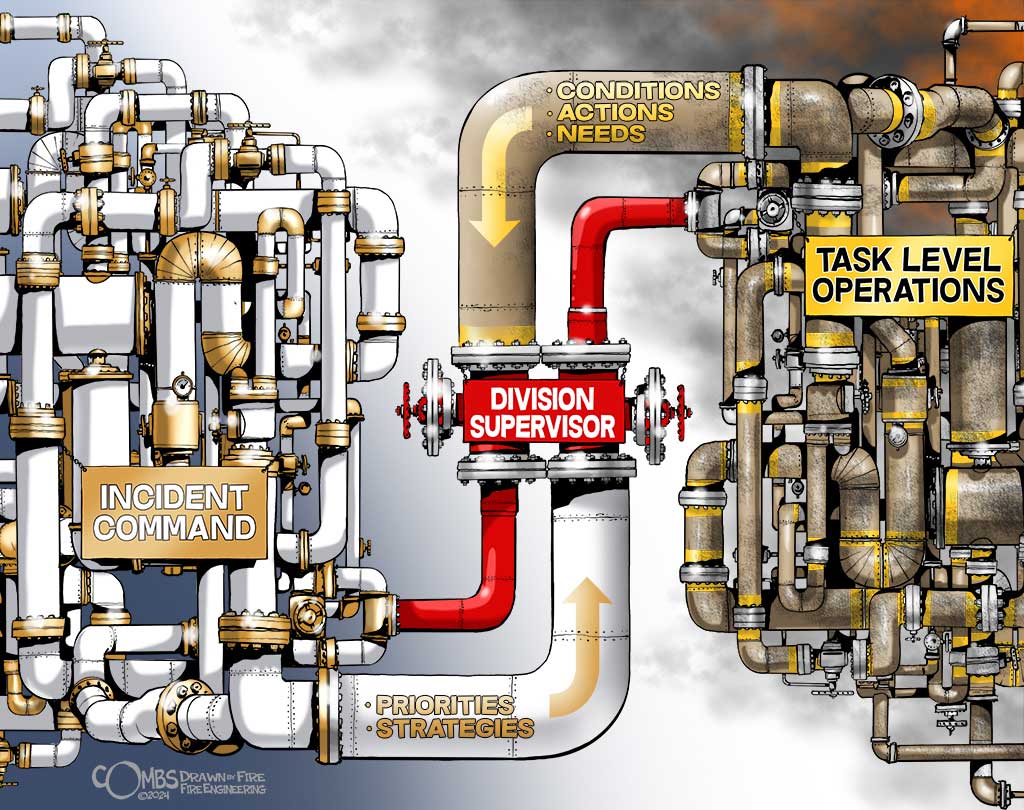Two-Pen Perspectives | Art by Paul Combs, Narrative by Anthony Kastros

The Tactical Gap is the space between the incident commander (IC) and the companies working at the front (where firefighters are engaged in battle). Regardless of whether it is a structure fire or any other incident, the Tactical Gap exists anytime you have an IC at a command post and crews working away from him or her. Whether standing on the front lawn of a house, sidewalk in front of an apartment building, or parked in the parking lot of a commercial fire, the IC will struggle with the Tactical Gap.
- Incident Command and Succession Planning
- Tactical Supervision for Known Rescues
- The NIOSH 5: Beyond Firefighter Line-of-Duty Deaths
The size of the Tactical Gap between the IC and the front is not measured by physical distance. The gap is measured by how many critical tactical factors fall into it. These critical tactical factors include size-up, communications, accountability, tactics of choice, time to task, incident alignment, and more. As radio traffic gets more out of control, the gap widens. As crews at the task level in the battle suffer auditory exclusion, the gap widens. As more firefighters and officers are heads down, task saturated, the gap widens. Officers are not thinking, they are doing. They are not seeing and hearing what is around them; they are tunnel visioned on the task right in front of them. And if they are inside the building, they are just surviving.
The result of a widening Tactical Gap is that more tactical factors fall into it and the IC’s reality of the fire and the crews’ reality are two completely different worlds. The crews are too close and the IC is too far to really know what is going on. Operations become sloppy, communications suffer, accountability is nonexistent, and meanwhile unnecessary risk is redlining. At the very least, your operations will be inefficient and ineffective. At worst, someone could get hurt. I have seen victims missed when the IC had no idea there were victims, crews working inside a building that was declared defensive, opposing tactics being implemented, and heard radio traffic that sounded like a cattle auction. All of these are symptoms of the Tactical Gap.
You can bridge the Tactical Gap with tactical division/group supervisors who function as the eyes and ears of the IC, and the guardian angel (safety/accountability officer) of the crews at the front. Like Major Winters from Band of Brothers, a good tactical supervisor knows the battlefield, enemy, troops, and tactics. He or she has command presence in battle and is trained, equipped, and entrusted to bridge the gap. Tactical supervisors make tactical decisions on behalf of the leader’s intent (IC’s incident priority and strategy). They do not need to ask for permission or tell the IC what everyone is doing all the time. That would create more radio traffic and slow down operations. Rather, they are unleashed to get the job done, herd the cats in the front, and make decisions within the boundaries of the plan. This creates faster time to task, less drag on operations, more aggressive tactics, and greater accountability and safety–all with less radio traffic!
Anthony Kastros began his fire service career in 1987, retiring as a battalion chief. He is the co-author of the textbook, Mastering Fireground Command – Calm the Chaos, and Mastering the Fire Service Assessment Center from Fire Engineering, and is the founder of Trainfirefighters.com. His faith and family are the most important things in his life.

